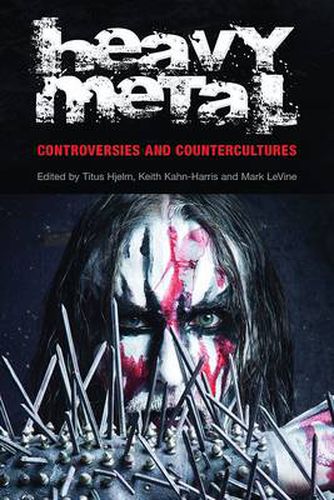Readings Newsletter
Become a Readings Member to make your shopping experience even easier.
Sign in or sign up for free!
You’re not far away from qualifying for FREE standard shipping within Australia
You’ve qualified for FREE standard shipping within Australia
The cart is loading…






Heavy metal is now over 40 years old. It emerged at the tail end of the 1960s in the work of bands including Iron Butterfly, Vanilla Fudge, Jimi Hendrix, Deep Purple, Led Zeppelin and - most importantly - Black Sabbath. In the 1970s and early 1980s, heavy metal crystallised as a genre as bands such as Judas Priest and Iron Maiden removed most of the blues influence on the genre, codifying a set of basic metal characteristics that endure to this day: distorted guitars, aggressive vocals, denim, leather and spikes. In broad terms, wherever it is found and however it is played, metal tends to be dominated by a distinctive commitment to ‘transgressive’ themes and musicality causing it to be frequently seen as controversial music. Controversies surrounding the alleged (and often documented) connection between heavy metal and, variously, sexual promiscuity, occultism and Satanism, subliminal messages, suicide and violence have all made heavy metal a target of moral panics over popular culture. Metal has variously embraced, rejected, played with and tried to ignore this controversy. At times, the controversy dies down and the previously transgressive becomes relatively harmless - as in the transformation of Ozzy Osbourne from public enemy to loveable dad. Still, metal remains irrevocably marked by its controversial, transgressive tendencies. Indeed, the various moral panics that metal has been subjected to are not only constitutive, at least in part, of metal scenes, but are encoded in metal’s transgression itself. As with hiphop’s ghetto roots, metal’s history of extreme sonic, lyrical and visual messages continue to give it credibility with new generations of fans today. The aim of this anthology is to analyse the relationship between heavy metal and society within a global context. It provides a thorough investigation of how and why metal becomes controversial, how metal ‘scenes’ are formed and examines the relationship between metal and society, including how fans, musicians and the media create the culture of heavy metal.
$9.00 standard shipping within Australia
FREE standard shipping within Australia for orders over $100.00
Express & International shipping calculated at checkout
Heavy metal is now over 40 years old. It emerged at the tail end of the 1960s in the work of bands including Iron Butterfly, Vanilla Fudge, Jimi Hendrix, Deep Purple, Led Zeppelin and - most importantly - Black Sabbath. In the 1970s and early 1980s, heavy metal crystallised as a genre as bands such as Judas Priest and Iron Maiden removed most of the blues influence on the genre, codifying a set of basic metal characteristics that endure to this day: distorted guitars, aggressive vocals, denim, leather and spikes. In broad terms, wherever it is found and however it is played, metal tends to be dominated by a distinctive commitment to ‘transgressive’ themes and musicality causing it to be frequently seen as controversial music. Controversies surrounding the alleged (and often documented) connection between heavy metal and, variously, sexual promiscuity, occultism and Satanism, subliminal messages, suicide and violence have all made heavy metal a target of moral panics over popular culture. Metal has variously embraced, rejected, played with and tried to ignore this controversy. At times, the controversy dies down and the previously transgressive becomes relatively harmless - as in the transformation of Ozzy Osbourne from public enemy to loveable dad. Still, metal remains irrevocably marked by its controversial, transgressive tendencies. Indeed, the various moral panics that metal has been subjected to are not only constitutive, at least in part, of metal scenes, but are encoded in metal’s transgression itself. As with hiphop’s ghetto roots, metal’s history of extreme sonic, lyrical and visual messages continue to give it credibility with new generations of fans today. The aim of this anthology is to analyse the relationship between heavy metal and society within a global context. It provides a thorough investigation of how and why metal becomes controversial, how metal ‘scenes’ are formed and examines the relationship between metal and society, including how fans, musicians and the media create the culture of heavy metal.